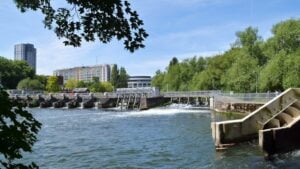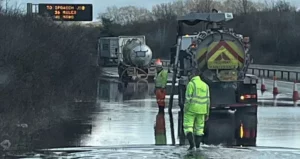A permeable road surface project is among 25 new flooding and coastal resilience projects across England that have been awarded government funding.
In Slough, the project will take the innovative Chinese ‘sponge city’ concept to address the challenges of surface water and river flooding in a heavily urbanised environment. This will include permeable road surfacing, green roofs and natural vegetation that better drains and manages rainwater.
This and the other projects, led by local authorities and delivered over the next six years, will receive a share of £150 million from Defra as part of the government’s new Flood and Coastal Resilience Innovation Programme and will be managed by the Environment Agency. They are part of the government’s long-term plan on flood and coastal erosion and a renewed effort to develop and test new approaches to tackle these threats.
The schemes will trial a wide range of different approaches to resilience tailored to local communities. Environment Minister Rebecca Pow said: “We’re investing a record £5.2 billion in 2,000 new flood and coastal defences over the next six years – but with the effects of climate change already being felt it’s vital that we combine this with long-term approaches to improve communities’ resilience.
“These 25 projects will not only help to inform future approaches to prepare communities for flooding and coastal change across the country, but also help reinforce the UK’s position as a world leader in innovation and new technology as we build back better.”
Emma Howard Boyd, Chair of the Environment Agency said: “The innovation programme is extremely exciting as it begins to put new aspects of the national flood and coastal erosion risk strategy to the test. What we learn will inform our approach to the climate crisis in the coming decades and it’s something to tell our international partners about at COP26.
“I’m particularly interested in the projects that test the ability of nature-based projects to generate revenue. If successful, these could be scaled up by private finance around the world, helping to prepare for climate shocks, restore nature and create jobs.
“The funding is in addition to the government’s record £5.2 billion investment in new flood and coastal defences to better protect 336,000 properties across England by 2027. The 25 areas have been selected following an expressions of interest process managed by Defra and the Environment Agency and assessed by an independent expert panel.”
Additional funding will be used to support the development of adaptation pathways in the Thames and Humber Estuaries, Yorkshire and the Severn Valley, to help plan future investment in flood and coastal resilience.
The projects are:
North East, Yorkshire and the Humber
- North East Lincolnshire and South Yorkshire – A project covering Grimsby, Immingham and Doncaster delivering town-wide resilience to surface water flooding. The project seeks to trial different approaches to engage with communities and retrofit sustainable drainage measures, such as water butts and rain gardens.
- York and North Yorkshire – A large strategic project looking at Swale, Ure, Nidd and Ouse catchments covering an area over 3000 km2. This project plans to undertake modelling and develop flood storage and natural flood management opportunities across the catchment.
- Northumberland – A project aiming to improve the flood resilience of at least six rural communities using a range of solutions, including testing and developing an enhanced flood warning system. This will be delivered using artificial intelligence and new sensor technology.
- South Tyneside – A project to support coastal adaptation by working along the north-east coastline, to undertake a number of activities including restoration of sub-tidal habitats (such as kelp beds, oyster reefs and sea grass) to protect against coastal erosion and flooding. The project learning will benefit the whole North East coastline.
- Stockton-on-Tees: To bolster resilience to coastal flooding through several activities, including creating new habitats such as saltmarshes and mudflats and trialling a ‘habitat bank’ to enable developers to invest in nature and resilience. The project will contribute to local economic regeneration by protecting coastal communities.
- County Durham – The council plans to develop a new approach to designing, delivering and monitoring sustainable drainage systems, such as raingardens, smart butts and street trees. This will include inviting UK based SMEs to run competitions to find innovative solutions to community sustainable drainage.
- Gateshead – Historic coal mining has impacted groundwater in urbanised areas of Northumbria. The project will use the latest monitoring technology to measure groundwater levels and trial a groundwater flood warning service. This trial will inform the case for developing a national ground water warning service.
North West
- Cumbria – This project aims to test a range of solutions to improve resilience to flooding, including working with farmers and landowners to deliver natural flood management projects such as leaky dams, tree planting and flood storage to slow the flow and store floodwaters in a range of locations.
- Rochdale – The project plans to target deprived and hard-to-reach communities in the Roch Valley, with high turnover and rented accommodation. The project is looking to proactively install property flood resilience, such as flood gates, across homes and local small businesses.
- Wyre – The project aims to enhance the coastal resilience of North West coastal communities to the consequences of climate change, such as from erosion and coastal flooding by creating Ecological Community Owned Coastal Buffer Strips (which could include natural wooden barriers to capture sediment, seeding of plants, establishing saltmarshes) that also capture carbon.
Midlands
- Northamptonshire – This project plans to assess how different resilience actions at catchment, community and property levels can be applied. This will include providing emergency response equipment to affected communities, setting up a surface water and groundwater flood warning system and live exercises of community flood plans.
- Lincolnshire – A project with Anglian Water to explore best practice for holistic management of groundwater resources, flooding and drought. This could include groundwater property flood resilience, localised flood warning systems.
- Staffordshire: A project aiming to improve the resilience of flooding in Staffordshire through a variety of activities, including developing new cutting-edge technology to forecast and map flood events as well as CCTV monitoring in high risks areas, helping to boost community resilience through an easier accessible web platform.
East of England
- Southend-on-Sea – The Catchment to Coast project plans to reduce surface water and coastal flooding to communities in Thurrock and Southend-on-Sea using natural flood management techniques, including rainwater harvesting, changing agricultural practices to reduce pollution and establish saltmarshes in the estuary.
- Suffolk and Norfolk – This project will deliver an innovative approach to integrated water management – helping to manage floods and drought. The project aims to capture surface water runoff during periods of flood and high rainfall, and reusing water for groundwater recharge and agriculture, improving water security in rural communities.
- Central Bedfordshire – This project will use new sensing technologies to help use flood risk infrastructure more effectively, improving the use of existing flood storage areas and investing in a network of telemetry to enable management of reservoirs across the catchment.
- East Suffolk and Norfolk – This project will pilot a coastal adaptation toolkit and a community adaptation masterplan to prepare the coast for a climate resilient future in an area with one of the fastest eroding coastlines in Europe.
London and South East
- Buckinghamshire: Trial for a new approach to groundwater flooding in Chilterns and Berkshire Downs, including plans for property flood resilience measures in up to 200 homes, groundwater monitoring (including innovative technology such as gulley sensors) and a Groundwater Flood Alert App for householders and businesses.
- East Sussex – This project will use a combination of new technologies to tackle surface water flooding, developing an integrated catchment wide model for the Eastbourne catchment. This will include installation of local digital equipment for monitoring water-levels and new boreholes to provide real-time monitoring for flood risk and local surface water flooding.
- Barnet – The London Boroughs of Barnet, Harrow and Brent have some of the fastest housing growth rates in London. The project will examine catchment-wide interventions to manage flood risk along the River Brent and the Silkstream and demonstrate how natural flood management can manage river flooding in urbanised areas.
- Richmond-upon-Thames – This project will modernise flood risk management in the Beverley Brook catchment by delivering property flood resilience, natural flood management and community preparedness.
South West
- Cornwall – Designating and protecting sand dunes on the Cornish Coast to protect coastal settlements and economies from coastal erosion and sea level rise. Six sites will be selected to deliver planting, saltmarsh restoration, protection of community infrastructure and support to SMEs, with learning transferred across the country.
- Devon – This project is focusing on catchments where there are significant risks from localised surface water flooding. The project will take a ‘catchment-wide’ approach to identify and implement nature-based solutions and sustainable drainage to help communities across Devon and Cornwall including collaboration with the Dartmoor and Exmouth National Parks.
- City of Bristol – The Frome Catchment Innovation Programme will use a mix of flood resilience measures that mirror the rural to city nature of the Frome catchment. This project will deliver restoration of the River Frome through the Yate Masterplan and Frome Gateway regeneration initiative.





















